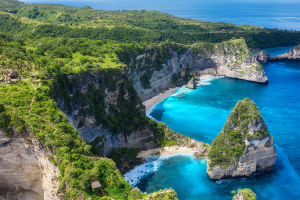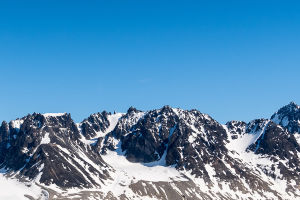Waterfalls are a stunning natural phenomenon where water flows down from the mountain wall or river bed suddenly falls and looks like a white cloth hanging from a distance.
Geologically, it is known as falling water, which is the phenomenon where river water falls vertically from high altitude when flowing through faults, depressions, and other areas. However, waterfalls are temporary features and will eventually disappear.
For a waterfall to form, the first condition is a difference in rock type. When a river crosses many rocky boundaries, and it flows from a hard rock bed to a softer rock bed, the softer rock bed will erode more quickly, and the slope where the two types of rock meet will become steeper.
Niagara Falls, part of the border between the United States and Canada, is an example of this condition. It has a mottled dolomite roof rock in its riverbed pressed against a succession of softer shales and sandstones.
The second condition for the formation of waterfalls is many strips of hard rock on the riverbed. The Nile River is the most typical example where many large waterfalls have been formed due to the river water eroding the river bed, exposing the hard crystalline basement rock.
Waterfalls are formed by the earth's internal and external forces. During the time of the river, a waterfall is a temporary feature that will eventually disappear due to various factors such as the fall of the waterfall, the volume of water, the type and structure of rocks, and others.
The location of the waterfall may recede upstream as the cliff or scarp is washed away by the current, or the erosion may cut deeper and bevel the entire reach, gradually causing the waterfall to disappear.
Many of the world's largest waterfalls have a clear "backward" tendency, such as Niagara Falls, which has a drop of about 50 meters today. According to the rock formation, the previous location was downstream, and the drop may have been 100 meters.
Currently, the waterfall retreats more than one meter upstream every year, and the drop is decreasing. At this rate, Niagara Falls will disappear completely in another 50,000 years.
Climate and precipitation are also factors that affect the formation and disappearance of waterfalls. In a dry climate, a waterfall may shrink or dry up, while in a rainy climate, the waterfall may become more spectacular.
Human activities can also have an impact on waterfalls, such as changing the water flow of rivers, polluting water sources, building dams and hydropower stations, etc. These activities may cause the waterfall to disappear or change its appearance of the waterfall.
Although waterfalls are temporary geological features, they are significant to both the Earth's ecosystems and human societies. Waterfalls can provide water and a living environment for the surrounding creatures, and they attract many tourists.
Therefore, we should protect these natural landscapes and take measures to reduce the impact of human activities on them.
Waterfalls are a natural wonder that forms due to a difference in rock type and hard rock in the riverbed. However, they are temporary and will eventually disappear due to various factors such as erosion, the type and structure of rocks, climate, precipitation, and human activities.
Therefore, it is crucial to protect these natural landscapes and reduce the impact of human activities on them for future generations to enjoy.


